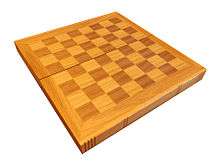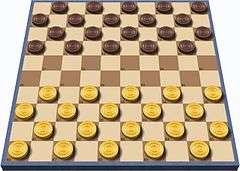Checkerboard

A checkerboard (American English) or chequerboard (British English; see spelling differences) is a board of chequered pattern on which draughts (checkers) is played.[1] Most commonly, it consists of 64 squares (8×8) of alternating dark and light color, often black and white. An 8×8 checkerboard is used to play many other games, including chess, whereby it is known as a chessboard. Other rectangular square-tiled boards are also often called checkerboards.
Mathematical Description

Given a matrix with rows and columns, a function ,
returns true if the cell is white and false if the cell is black. The element is black.
Games and puzzles using checkerboards

Martin Gardner featured puzzles based on checkerboards in his November 1962 Mathematical Games column in Scientific American. A square checkerboard with an alternating pattern is used for games including:
- Amazons
- Chapayev
- Chess and some of its variants (see chessboard)
- Czech draughts
- Draughts
- Frisian draughts
- Gounki
- International draughts
- Italian draughts
- Lines of Action
- Pool checkers
- Russian checkers
- Turkish draughts
The following games require an 8×8 board and are sometimes played on a chessboard.
References
| Look up checkerboard in Wiktionary, the free dictionary. |